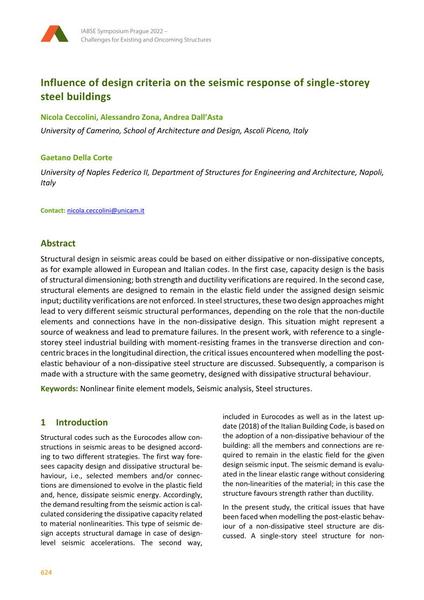Influence of design criteria on the seismic response of single-storey steel buildings

|
|
|||||||||||
Bibliographic Details
| Author(s): |
Nicola Ceccolini
(University of Camerino, School of Architecture and Design, Ascoli Piceno, Italy)
Alessandro Zona (University of Camerino, School of Architecture and Design, Ascoli Piceno, Italy) Andrea Dall’Asta (University of Camerino, School of Architecture and Design, Ascoli Piceno, Italy) Gaetano Della Corte (University of Naples Federico II, Department of Structures for Engineering and Architecture, Napoli, Italy) |
||||
|---|---|---|---|---|---|
| Medium: | conference paper | ||||
| Language(s): | English | ||||
| Conference: | IABSE Symposium: Challenges for Existing and Oncoming Structures, Prague, Czech Republic, 25-27 May 2022 | ||||
| Published in: | IABSE Symposium Prague 2022 | ||||
|
|||||
| Page(s): | 624-636 | ||||
| Total no. of pages: | 13 | ||||
| DOI: | 10.2749/prague.2022.0624 | ||||
| Abstract: |
Structural design in seismic areas could be based on either dissipative or non-dissipative concepts, as for example allowed in European and Italian codes. In the first case, capacity design is the basis of structural dimensioning; both strength and ductility verifications are required. In the second case, structural elements are designed to remain in the elastic field under the assigned design seismic input; ductility verifications are not enforced. In steel structures, these two design approaches might lead to very different seismic structural performances, depending on the role that the non-ductile elements and connections have in the non-dissipative design. This situation might represent a source of weakness and lead to premature failures. In the present work, with reference to a single- storey steel industrial building with moment-resisting frames in the transverse direction and con- centric braces in the longitudinal direction, the critical issues encountered when modelling the post- elastic behaviour of a non-dissipative steel structure are discussed. Subsequently, a comparison is made with a structure with the same geometry, designed with dissipative structural behaviour. |
||||
| Keywords: |
seismic analysis steel structures Nonlinear finite element models
|
||||
| Copyright: | © 2022 International Association for Bridge and Structural Engineering (IABSE) | ||||
| License: | This creative work is copyrighted material and may not be used without explicit approval by the author and/or copyright owner. |
||||
